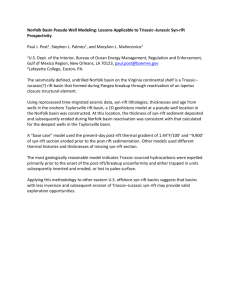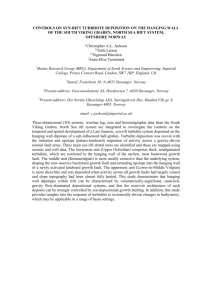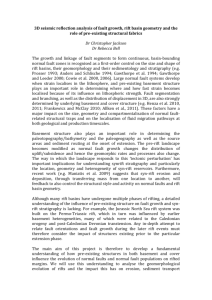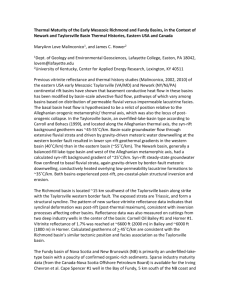File
advertisement
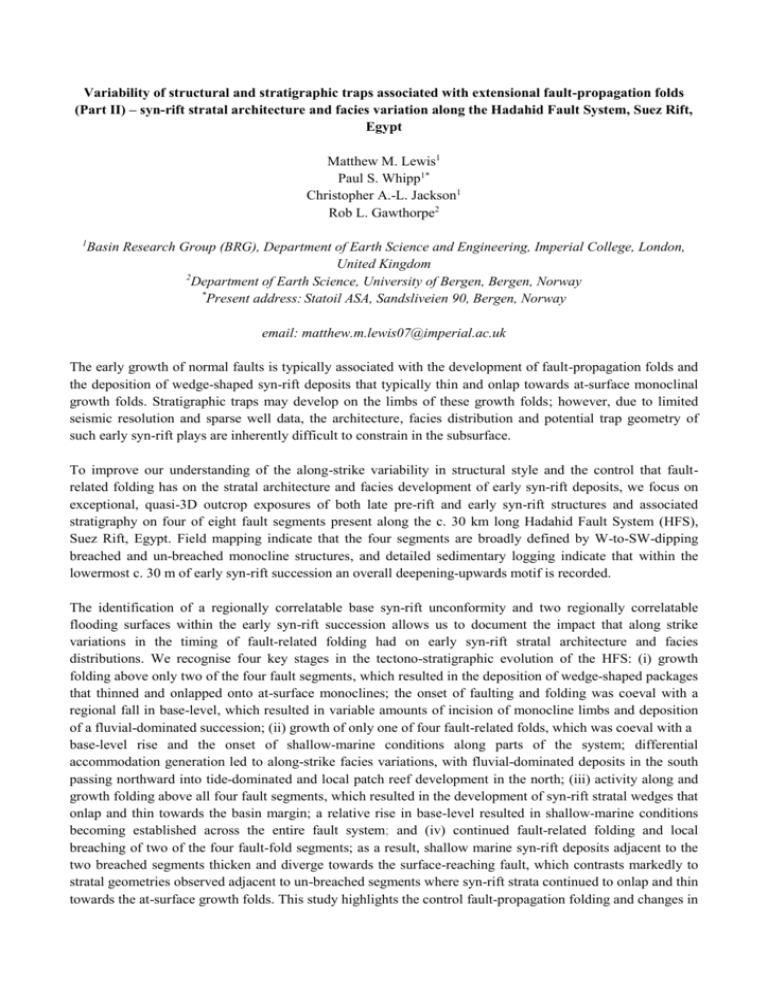
Variability of structural and stratigraphic traps associated with extensional fault-propagation folds (Part II) – syn-rift stratal architecture and facies variation along the Hadahid Fault System, Suez Rift, Egypt Matthew M. Lewis1 Paul S. Whipp1* Christopher A.-L. Jackson1 Rob L. Gawthorpe2 1 Basin Research Group (BRG), Department of Earth Science and Engineering, Imperial College, London, United Kingdom 2 Department of Earth Science, University of Bergen, Bergen, Norway * Present address: Statoil ASA, Sandsliveien 90, Bergen, Norway email: matthew.m.lewis07@imperial.ac.uk The early growth of normal faults is typically associated with the development of fault-propagation folds and the deposition of wedge-shaped syn-rift deposits that typically thin and onlap towards at-surface monoclinal growth folds. Stratigraphic traps may develop on the limbs of these growth folds; however, due to limited seismic resolution and sparse well data, the architecture, facies distribution and potential trap geometry of such early syn-rift plays are inherently difficult to constrain in the subsurface. To improve our understanding of the along-strike variability in structural style and the control that faultrelated folding has on the stratal architecture and facies development of early syn-rift deposits, we focus on exceptional, quasi-3D outcrop exposures of both late pre-rift and early syn-rift structures and associated stratigraphy on four of eight fault segments present along the c. 30 km long Hadahid Fault System (HFS), Suez Rift, Egypt. Field mapping indicate that the four segments are broadly defined by W-to-SW-dipping breached and un-breached monocline structures, and detailed sedimentary logging indicate that within the lowermost c. 30 m of early syn-rift succession an overall deepening-upwards motif is recorded. The identification of a regionally correlatable base syn-rift unconformity and two regionally correlatable flooding surfaces within the early syn-rift succession allows us to document the impact that along strike variations in the timing of fault-related folding had on early syn-rift stratal architecture and facies distributions. We recognise four key stages in the tectono-stratigraphic evolution of the HFS: (i) growth folding above only two of the four fault segments, which resulted in the deposition of wedge-shaped packages that thinned and onlapped onto at-surface monoclines; the onset of faulting and folding was coeval with a regional fall in base-level, which resulted in variable amounts of incision of monocline limbs and deposition of a fluvial-dominated succession; (ii) growth of only one of four fault-related folds, which was coeval with a base-level rise and the onset of shallow-marine conditions along parts of the system; differential accommodation generation led to along-strike facies variations, with fluvial-dominated deposits in the south passing northward into tide-dominated and local patch reef development in the north; (iii) activity along and growth folding above all four fault segments, which resulted in the development of syn-rift stratal wedges that onlap and thin towards the basin margin; a relative rise in base-level resulted in shallow-marine conditions becoming established across the entire fault system; and (iv) continued fault-related folding and local breaching of two of the four fault-fold segments; as a result, shallow marine syn-rift deposits adjacent to the two breached segments thicken and diverge towards the surface-reaching fault, which contrasts markedly to stratal geometries observed adjacent to un-breached segments where syn-rift strata continued to onlap and thin towards the at-surface growth folds. This study highlights the control fault-propagation folding and changes in base-level can have on along-strike variations in the stratal architecture and facies development in early synrift reservoirs associated with forced fold-related stratigraphic traps. In addition, we demonstrate that value that well-exposed outcrop analogues can have when attempting to reduce subsurface uncertainty during hydrocarbon exploration and production in rifts.
